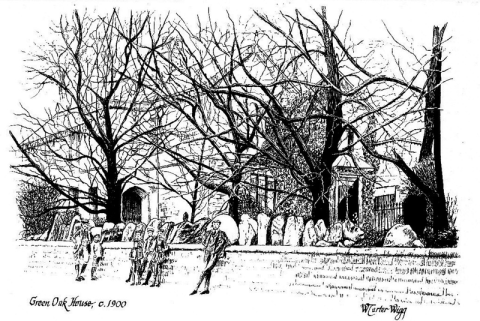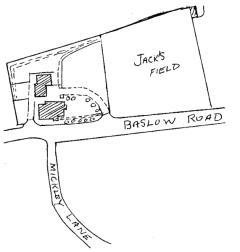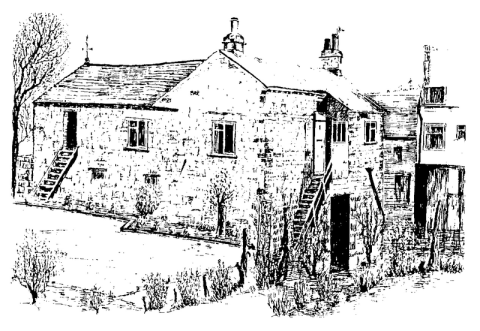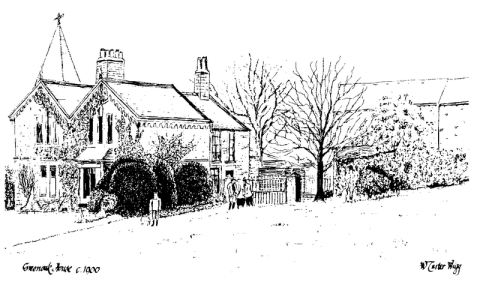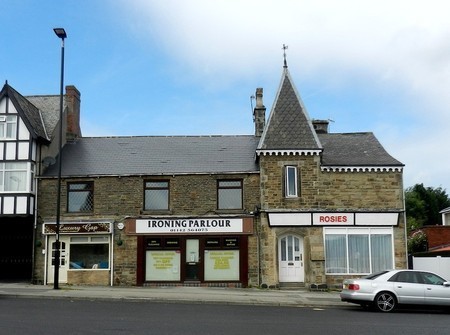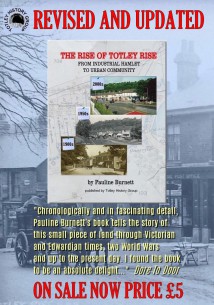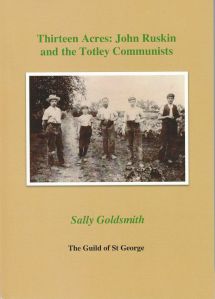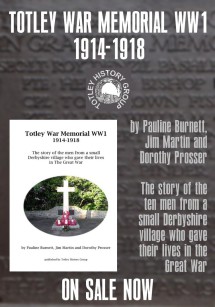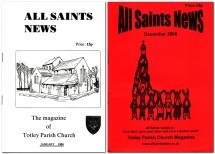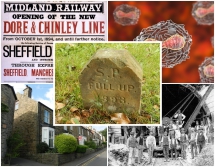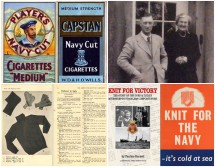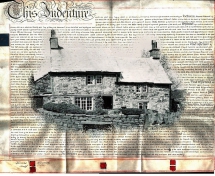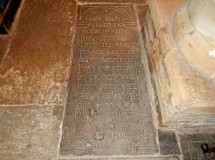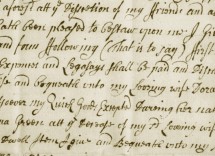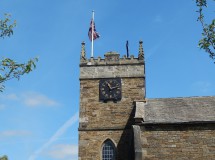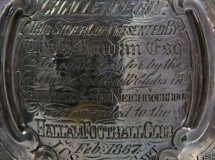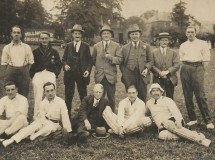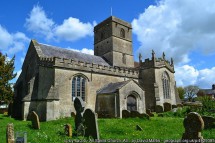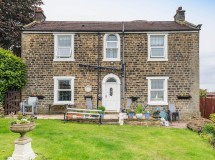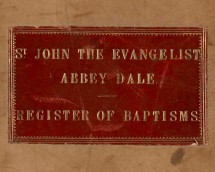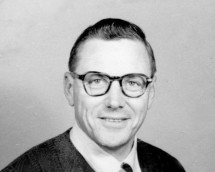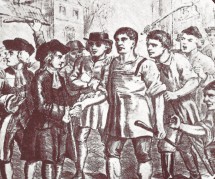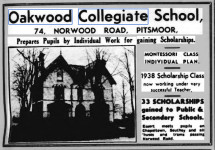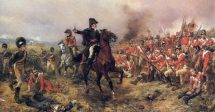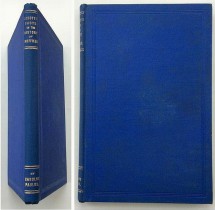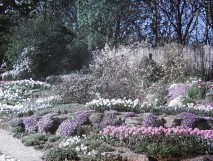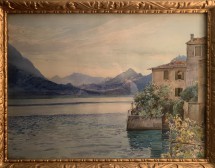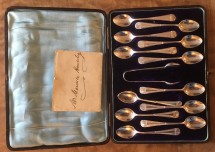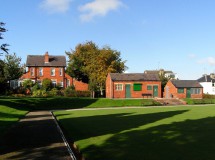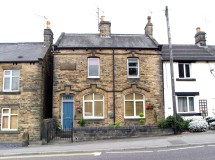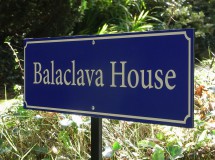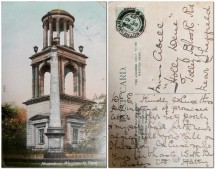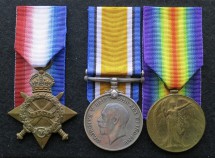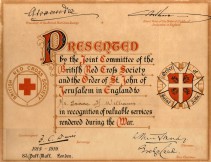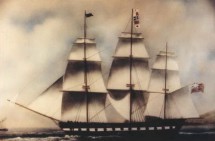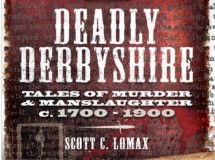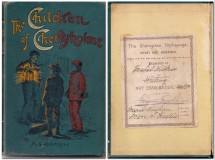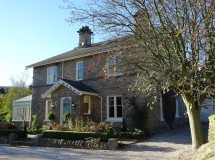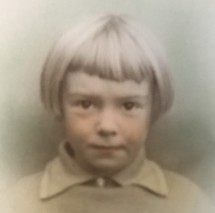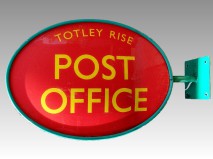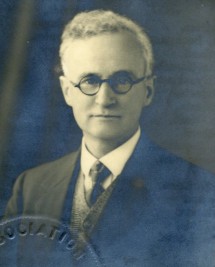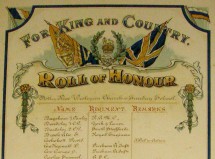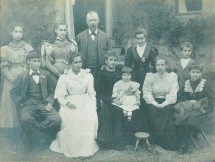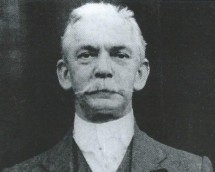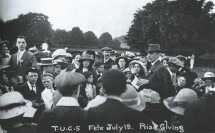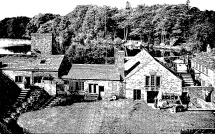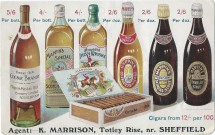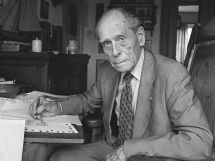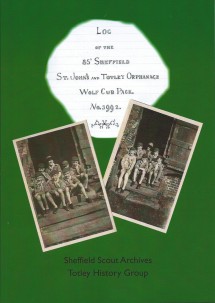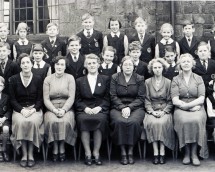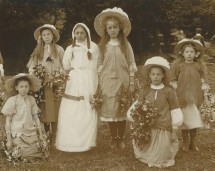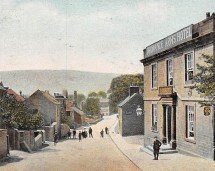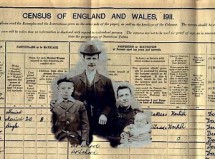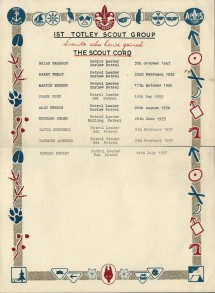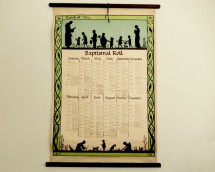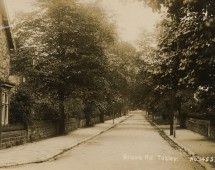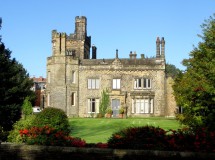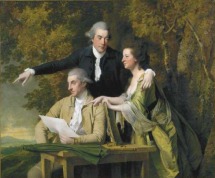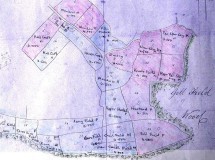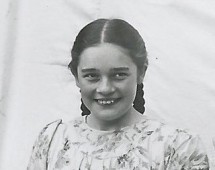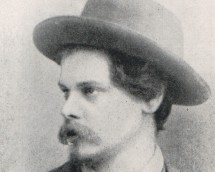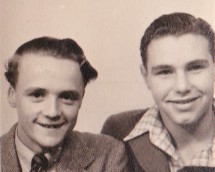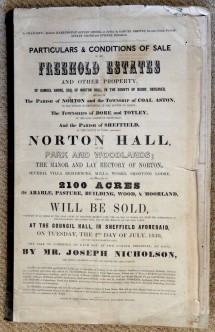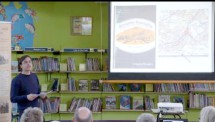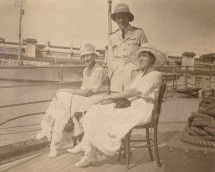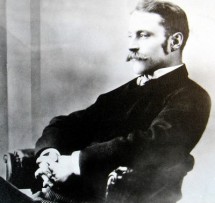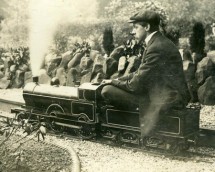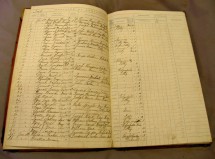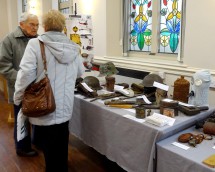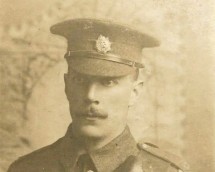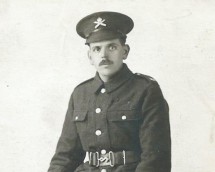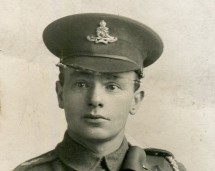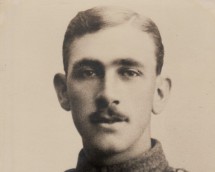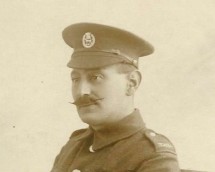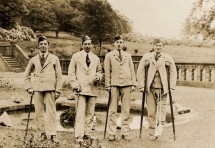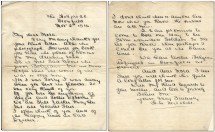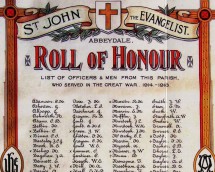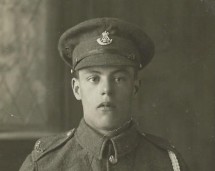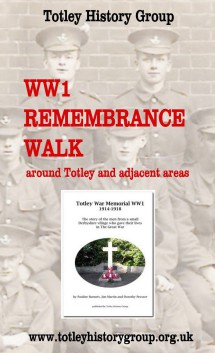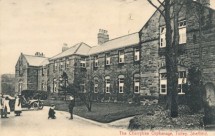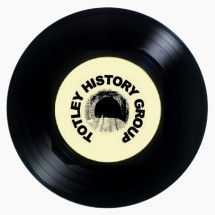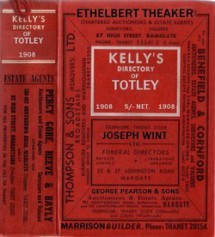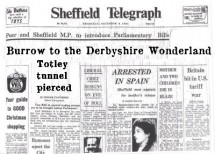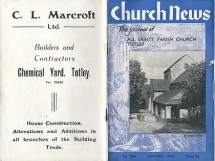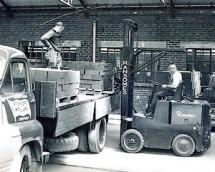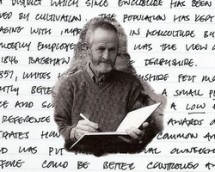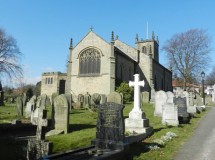Greenoak House
J. Deryck Bell
When nostalgia's ageless fingers beckon us backwards to well-loved occasions, we often recall them with more clarity than things which occurred a month a week or even a day ago. As we grow older, we are all similarly affected by this ebb tide of memory, which can trigger off a strong chain of associated images drawn out of the years, like a string of multicoloured handkerchiefs pulled magically and endlessly from some conjuror's hat. My good friend and correspondent, John T. Capron, who at 90 year, of age, the last living member of the Athol Capron family who Lived at Greenoak House, from 1899 to 1911, now living in North Yorkshire, has taken me on a privileged journey into nostalgia, recalling the times when he lived there and his subsequent life and adventures.
There must be few people living in Totley today who can remember Greenoak House as it was at the turn of the century, or even before 1914; then a family house, standing in its own grounds, with an adjoining paddock, separated from the road by a stone wall with beautifully fashioned and rounded capping stones, (some still to be seen on the wall fronting number 150 Baslow Road). Between this dwelling and the off-licence, was the original driveway entrance to Greenoak House.
In 1899, Athol Capron, a well-qualified and experienced engineer from Erith in Kent, came to Sheffield with his wife and four children, to take a management job with Davy Brother's Boilermakers, then an almost bankrupt company. He took his family (complete with donkey and cart), to live at Greenoak House, which he rented from Ebenezer Hall of Abbeydale Hall, for £90 per annum. They arrived in a bitterly cold February and were quite unprepared for the bleakness of the snow-covered Derbyshire moorland, after the much softer climate south of the Thames. After the first shock they soon settled in and as spring and summer came, they came to love the area. The donkey was put to graze in the paddock, which from then on was called Jack's field. At that time there were four children: Maurice aged 9, Dosy (Dorothy) 7, John T. 3 and Gerard 1 year old. In 1903 their last child, Clare was born at Greenoak.
Athol and Catherine Capron were a well-balanced and devoted couple, very good to their children. He was calm, strong and firm, but a kindly v man; she was lively and intelligent and to the children she was more like an elder sister; well educated, fluent in French and German, she had a big influence on their early education, often reading aloud to them from Walter Scott and several French stories. A firmly-based and loving family.
Being a man of great energy, Athol Capron left Greenoak early every morning on a bicycle, sometimes catching a train at Dore and Totley station, but often he would ride right through to Park Iron Works. An old toolmaker told John Capron that his father was the only man he ever saw bicycling with an umbrella up! He Look to Davy Brothers his expertise, inventiveness and energy and did a wonderful job building up the firm from near liquidation. When he became Managing Director, he steadily expanded the engineering side, which was fortuitous for much later, when war broke out in 1914, they were able to produce vast amount of presses and shell-making machinery.
Every summer, Mr and Mrs Capron would invite .all the staff and foremen of Davy Brothers to tea games and supper; 25 to 30 would arrive in charabancs at Greenoak House. The supper was laid out in the large old coach house, which would be decorated by Dosy and John, mostly with foxgloves gathered from the wood overlooking Totley Brook: a busy time for all the family, but great fun. On one occasion, young Gerard caused some hilarity, when carrying replenishments of bread and butter across the lawn, oblivious of the fact that the plate in his hand was so angled that he was leaving behind a trail of bread and butter, his gaze being fixed on the assembled company.
Here was another Athol Capron family, for he was really loved by all the Davy Brothers people. Not only was he keen on and encouraged apprentices, but did everything he could to help the foremen, being foremost in getting a large house in Burngreave Road as a Club House for the Foremen’s Mutual Benefit Society.
Davy Brothers apart, he became the leader of all the other and much bigger Sheffield Steel and Engineering Employers and for years was President of their federation, chairing endless committee meetings and conferences with the unions; not an easy role for some of the larger firms' directors were often jealous and awkward. Fortunately he had good reputation with the Unions; they knew that he was fair and also a practical man who could go on the machines, as well as being a first class carpenter. He had the reputation of being the most stubborn man in Sheffield, which is saying quite a lot (stubborn men not being uncommon in the Sheffield Steel Trades) and no doubt he needed to achieve what he did.
Mr Capron, a very busy man, did not see much of his family during the week, but on Saturdays in the summer he would often hire an open top landau from Mr Wint of Dore and Totley station and a Wint son would drive the family to the Peacock at Owler Bar, or to Fox House, where they would take long country walks, for they were very much an open air family; their driver would wait at: the inn for their return.
Athol Capron was a very public spirited individual with boundless energy, who it seemed, could turn his hand to anything, being involved with Hospital Committees and an active member of the Totley Parish Council, along with Squire Ellison, W.A. Milner and farmer Creswick, probably the four most active members of Parish Meetings.
At one time he bought a farm at Holmesfield, part of Woodthorpe, meaning one day to retire up there, but he never did. Instead he built a large stone house near Hathersage and in 1911 the family left Greenoak and went to live there.
About 1930, Firths and John Brown put capital into Davy Brothers and eventually took over. Jealous Directors of these firms soon had Athol Capron out. Fortunately good friends in the thriving Newton Chambers Company invited him to join their Board, where he worked happily until he retired. He died at Hathersage in 1937, followed by his wife in 1939.
Young Caprons of Greenoak
One of John Capron’s earliest memories was at being “lost at Dore”, about 1900; being taken in a double pram with his brother Gerard, to explore “wilds of Dore”, by 2 ladies, who got lost. They must have travelled miles in wrong directions and when darkness fell they panicked, a panic which was felt by John, but they ploughed on and finally their way back to Greenoak; the 2 children being soothed down with dollops of golden syrup.
Another early memory was of going into his father’s dressing room into the tower which opened out from his parents’ bedroom to watch him shaving with a cut-throat razor. So fascinated was he that he took to going in every morning to watch the operation, whilst outside and overhead was the endless chatter of starlings, either making their nests or flying past the window.
Greenoak was at that time deep in the heart of the countryside and John remembers a certain air of peacefulness in the environment; of being awakened in the morning to the song of thrushes in the lilac bushes by the entrance of the yard gate and of going to sleep to the drowsy churr of corn crakes in Jack’s field.
He and his younger brother Gerard with very good friends and companions; Morris their elder brother either being away at boarding school at Matlock or later apprenticed at Vickers. When John was 7, he took charge of the few poultry they kept, a chore which he enjoyed. The 2 boys kept rabbits in the wooden hutch in the yard corner opposite the coach house, occasionally letting them out in Jack’s field.
Roaming through the wood overlooking Totley Brook Road and fishing for sticklebacks and loach in the brook was a constant delight. They were also great cyclists riding as far as Southwell, Lincoln and often up to watch work on the Howden Reservoir.
With the family, they went for long moorland walks on forbidden drives and footpaths. Their father knew Payne Gallwey, the Duke’s agent, who gave him a key to the gates, so they could wander at will, defying keepers if challenged, which they often were. Keepers in those days were far more aggressively active in keeping people out, bearing no resemblance to Seth Armstrong of Emmerdale Farm! Mr Green, a Totley Postman, used to cut John and Gerard’s hair, placing a bowl over their heads to get the correct shape and then blowing the hairs away. They waiting his powerful buffs on their skin and eventually they were taken to a hairdresser to Purkiss, who had a shop near the Town Hall in Sheffield. There were 2 doctors in the area, Doctor Parsons, who lived at the first house on Totley Brook Road and their own Doctor Thorn who lived in the Beauchief area and visited them at Greenoak in a dog-cart. Doctor Parsons had a car, which failing to fire one day, was stuck on the road just outside their backyard gate. The young Caprons all poured out and enjoyed pushing him towards Totley Rise, when after about 50 yards it fired and off he spluttered back to his surgery. Doctor Parsons always wore an overcoat with a high fur collar; the children thought he looked like a vulture perched high up and peering overhead!
John remembers many people and families who lived in the area before they left. The young Caprons in their tender years felt in some awe of the Milners of Totley Hall who were always graciously kind, inviting them to several annual “occasions” at the Hall; One being the visit at “daffodil” time, when they were taken around the garden by Mrs Elsie Milner herself. They liked her; she was nice and not too formal. Sometimes they joined Marjorie Milner, the only daughter, who drove the 2 boys in a giant sized wash basket mounted on wheels behind an agile young brown donkey, called Betsy, down the lane and along rough cart tracks before the woods.
Marjorie, a veritable “Tottinglei Boadicea”, stood up to drive, urging on the young donkey to greater speeds with shouts of “WHY OH BETSY”, while their poor sister, Dosy, lumbered after them, driving their poor old Jack in the more conventional pony cart. They liked Roy Milner but were frightened of his older brother Billy. Some years later in 1914, early in the war, Roy was killed in action; a terrible local tragedy.
Not far from Greenoak lived the Earnshaws of Totley Grange and the Ellisons who owned the big house down Hillfoot Road, almost opposite Penny Lane. John will never forget going to a party there and being coerced into dancing, ploughed manfully around the room with Mrs Ellison, treading so heavily on her long black silk skirt she immediately cast him lose!
Down the lane (as they always called it) leading to Mickley were quite a few cottages, mostly inhabited by railway employees; Cook, signalman; Nunn, gardener “later, signalman and “Jack of old trades”” and old Mr Wing who kept an Alsatian. Another Totley man was Jim Marshall who was their gardener and handyman. His young son Neville was often round at Greenoak helping out. The vicar at Abbeydale was J A Kerfoot and the one at Dore, Rev Gibson, who had 2 daughters, Queenie and Violet and a son Claude. Athol Capron sometimes walked up to Holmesfield Church where the vicar was old Mr Bradshaw. John recalls the small open bus running to and from Cross Scythes and the station; a one horse affair driven by Jim Larder, a curly black haired lively character, always full of repertoire, especially with the lady passengers.
Before they left Greenoak John and Gerard were promoted to rat catching using an air gun and traps. They had an exciting field day when Colin Thompson from Totley Rise “an elegant and dashing butcher who hunted and rode a spirited horse” brought ferrets and a dog to clear rats from the old barn beyond Jack’s field and their stable block. They really loved living at Greenoak and always understood it had been the Toll Bar House.
In many ways they were sorry to leave but their father had the urge to build himself a good stone house further into Derbyshire, only 25 acres, at Outseats, just clear of Hathersage and convenient for him to take the train to Sheffield.
John O’Greenoak
Both John and Gerard had been educated at home until they reached 10 years of age, when each boy was sent to a boarding school in Oxford where their father had been educated. Later they continued their education at Wellington College, again following their father’s footsteps. It was here that Gerard, a very independent character, did not conform regularly to the etiquettes of the college, where individuality was frowned upon. One night with another wild spirit, he took a night ride to Reading after lock-up. On returning, he climbed the high tower and set the clock hands back! Found out, he was kept back for 2 days at the end of term and John, often caught in the crossfire of his younger brother’s misdeeds stayed on with him.
When war broke out in 1914 John joined the college training corpse and in Sheffield his elder brother Maurice, now an engineer at Davy Brothers, had a promising career ahead, volunteered for the army. Much to his sorrow he was turned down to a varicosed leg condition and for the same reason he left Davy Brothers and went into pig breeding in Lincolnshire with some success. He pioneered open air pig breeding and marketing before the intensive era. His wife, of typical Lincolnshire farming stock, was a great help to him and died only recently 104.
In November 1915, when junior officers were falling like 9 pins in France, John, just 19 years of age and in his last year at Wellington, was surprised to learn that he had been granted a Commission in the Field Artillery (RFA) as second Lieutenant and must report to his Training Brigade with the 49th West Riding) Division at Ripon on the 1 January 1916. Feeling rather a fraud because he was only a private in the College Corps, he made a hurried departure from Wellington in order to get kitted out in Sheffield to meet the deadline at Ripon. So, second Lieutenant John T. Capron, like many other “soldat malgré lui”, arrived at Ripon Station on 1 January 1916 and “proceeded” through the town to quarters near Studley Royal Park.
Passing various “other ranks” on route he was more than embarrassed at having to acknowledge their methodical salutes, something he escaped in France at least in the battle areas, where saluting was not required.
He enjoyed training with the 49 th West Riding Division learning to ride and to bring their 18 pounder field guns into action “open warfare”, over the fields and woods of Studley Royal and Galphay. Training alongside them was the Northumberland Artillery and the “Geordies” was his future brother-in-law, Bertie Claudet, who had already out and wounded whilst serving of the ranks HAC. He was given a Commission on coming out of hospital in Sheffield, where in fact he met and later married Dosy.
During the Somme holocaust of 1916 John was drafted out with other reinforcements to the 56 th London TA Division, which had suffered heavy losses in the July attack. He served a year with their Ammunition Column, which involved endless ferrying shells by night convoys of horse and mule-drawn limbers over the dreadful aftermath battlefield of the Somme. In the autumn when the mud got too deep for the wagons the 18 pounder shells were packed into canvas panniers, 4 each side, slung over the animals backs. Each driver lead, or more often dragged his reluctant pair, under cover of night, 3 or 4 miles from the “dump” to the gun-site.… A far cry from the peace of the Ripon countryside!
In September 1917 John was posted to the 109 a regular 18 pounder battery defending the lines at Arris, their guns being deployed in the shunting yards. It was in that beleaguered town near the station that John was wounded and sent down to hospital at Paris Plage with shell splinters in the head and right thigh. A month later he was back with the 109 battery. Their worse was 29 March 1918, when the Germans made their last great attack, bending the 5 th army, but not breaking through. They were holding the line in from of Arris, a key point, and were under intermittent barrage for 17 hours. Four of their 6 guns were knocked out and 2 sergeants and several of the gun crews were killed.
Towards the end, the war had been fast- moving, open warfare, the old trenches of the Hindenburg Line, before Arris left far behind. The battle-scared 109 battery fought on, most days moving forward covering defence and attack and coming into action several times between dawn and dusk. The command of the now depleted battery was shared amicably by John and 2 other young subalterns, their being no senior officers left. All 3 were “Mentioned in Despatches” and recommended for decoration.
The battery finished up on 11 November 1918, Armistice Day, a few kilometres south of Mon, where in August 1914, they were probably the first 18 pounder guns to open fire in defence of the bridge and the barricades there. John stayed with the battery until demobilised and was out of the army by Easter 1919.
Return to Greenoak
When a young soldier battle-scarred and weary returns home having passed “through the mud and blood to the green fields beyond”, life for him for will never be quite the same again. He may find those fields not quite so freshly green as he had imagined, but rather ready for the resowing. So it was with John Capron, being country-bred and a country-man at heart, he decided that his future lay in farming, so to that end he enrolled at the Shropshire Agricultural College. There on the college he met Ruth Adam, who in fact taught him how to milk. They were married at Kidderminster in 1922. Unable to raise enough capital to get into farming he returned to the Totley area, where they bought a small stone house at Holmesfield and John became articled to a solicitor in Sheffield.
His route to work was quite arduous, down Holmesfield wood, striking left over to the fields at Totley Hall Lane, to catch a bus to Dore and Totley Station for a train to Sheffield; returning in the evening by the same route, often laden with household goods and food, which Ruth was unable to obtain at Mellors, the only shop in Holmesfield. A very tiring time for John, who having worked all day spent most nights studying for his law exams.
One night a young man sneaked into the house and stole John’s case which he had left in the hall. Fortunately their dog stopped him getting away and on John arresting him the young burglar asked to be taken into custody. So tired as he was and having no telephone John had to make a second journey that day down the fields to Totley Police Station, where the young miscreant got a bed for the night. On the way down John had wondered if the lad would make a break for it and he did not and by the time they had got to the police station John was feeling sorry for him; a sad case, unemployed, bad home background, quite rudderless. John had to go to court of course, but was pleased the lad got off lightly.
During the period 1922 to 1927 when articled in Sheffield John, at his father’s invitation, went down to Park Iron Works at Brightside every day to have lunch in the staff dining room. Their Athol Capron presided at the head of a table seating about 16, carving a hot joint with 2 veg, followed by some solid pudding. A friendly family gathering; a relationship which extended throughout the firm, small wonder there was no industrial unrest at Park Iron Works. Athol Capron had been awarded the OBE for his services during the war and in 1931 was made a Justice of the Peace for the City of Sheffield. By 1927, John, now 31, having pass all his law exams left Sheffield with Ruth and their daughter Jane, born 1923, and took a position at an old established firm of solicitors in Norfolk. There he stayed until Hitler’s war when in 1940 still on Army Reserve he was recalled to the Army serving on Coastal Defence with naval guns at various positions from The Orkneys south to Lowestoft until the war was over and he was once again “demobbed”. Thereafter, he started on his own near the Norfolk Broads, carving out for himself a very successful country practice.
Meanwhile, until 1937 Athol and Catherine Capron with Gerard and Claire had been living at Westlow, the family home near Hathersage. Gerald excelled at carpentry and also did some fine wood carving. Clare was deeply involved in country matters, a born naturalist, did very good flower sketches and was a wonderful bird mimic. Many people in Hathersage remember her talks and demonstrations. Neither Claire or Gerald never married.
They were devoted companions and lived together all their lives. When their parents died Athol in 1937 and Catherine in 1939, they left Hathersage and bought a smaller house at Brockenhurst in the New Forest, and Clare often made long summer visits to friends in Hathersage. On her last visit in 1970 (just before she died) she was accompanied by her 2 remaining brothers John and Gerard, when a friend drove them to see their old home at Greenoak.
When you return to a place after a long time, the difference between your memories and the realities you meet can be quite shattering. For memory makes no allowance for that greatest of all realities … change. Thus it was with the 3 remaining Caprons. At first they could not find their old home; it was nowhere to be seen. Not until they crossed the busy road to Mickley Lane and looked back did they see the beleaguered tower and their old home. Totally encapsulated in a shopping parade, and the paddock “Jack’s field” completely overbuilt. They were shocked into a bewildered silence, dazed and dismayed, John remembered that change inevitably hurts someone; he now finds comfort in the thought of so many new lives and families active and happy where they grew up; he sees evidence indeed of the community life and good fellowship in The Totley Independent itself.
When he retired in 1960, he and Ruth settled happily to village life in Gillamoor, North Yorkshire strategically between Hull and Scotland where their 2 daughters lived. They kept poultry and one favourite goat, and enjoyed involvement in local affairs. In 1984 came the death of brother Gerard and the same year John lost Ruth, the end of a 62 year partnership. He moved down to the small town of Kirbymoorside. Here in his small comfortable cottage, with good friends and neighbours he lives with his memories. Perhaps because of his legal training his early disciplines and teaching of his parents, John has lately developed a real craving to see justice in every walk of life.
He deeply regrets the tendency to overlook the claims of the victim in compassion for the criminal – with resulting punishments by the capital courts not fitting the crime. For all his 90 years he is still a prolific writer and constant contributor to The Yorkshire Post; John T. Capron (John O’Greenoak) a kindly, perspective, compassionate … a good friend, tres gentil.
Search Our Website Here
September
October
November
Unless stated otherwise our meetings are held in Totley Library on the 4th Wednesday of each month at 7.30pm.
Pauline Burnett's book The Rise of Totley Rise has been revised and updated. It tells the story of this small piece of land from 1875 when there was only a rolling mill and chemical yard alongside the river a mile from Totley, through Victorian and Edwardian times, two world wars and up to the present day. It has 94 pages including a useful index and many illustrations from private collections. The book is available now from Totley Rise Post Office priced at £5, or through our website when an additional charge will be made to cover packing and postage.
A few copies are still available of Sally Goldsmith's book Thirteen Acres: John Ruskin and the Totley Communists. Totley was the site of a utopian scheme funded by art critic and social reformer John Ruskin. In 1877 he bought 13-acre St. George’s Farm so that nine Sheffield working men and their families could work the land and, to keep themselves busy, make boots and shoes. Sally tells an engaging story from our history with a quirky cast of characters including Ruskin himself, the poet and gay rights activist Edward Carpenter and Henry Swan, a cycling, vegetarian artist and Quaker. The book is available to order online from the The Guild of St. George by following this link.
A recently discovered box of WWII correspondence reveals the story of how a small group of ladies from Dore and Totley recruited knitters from the west of Sheffield and how their efforts made them the country's greatest provider of Comforts for the Minesweeping crews of the Royal Navy. The story is told in Knit For Victory, a new book from Totley History Group. Written by Pauline Burnett, it has 82 pages and many illustrations. It is on sale in local shops and via our website. Further information about the correspondence is in this inside page of our website: Dore & Totley Minesweeping Trawlers Comforts Fund.
The story is told in Totley War Memorial WW1 of the ten men from our village who gave their lives in the Great War. Written by Pauline Burnett, Jim Martin and Dorothy Prosser, a chapter is devoted to each of the soldiers with a family tree followed by as much information as could be discovered about the men and their families. There is also information about their military careers and the actions in which they lost their lives. The book has 64 pages and is illustrated throughout with photographs of the men, their families and the houses where they lived.
Totley All Saints' Church Parish Magazines for the years 1985-2006 with notices of baptisms, marriages and funerals and accounts of spiritual, educational, charitable and social matters in the village. Scanned in full, including advertisements from local traders.
In 1893 during the building of the Totley Tunnel there was an outbreak of smallpox amongst the navvies which spread to some of the local population. 17 people were buried in communal graves in Dore Churchyard, 6 from "Green Oak" (Lemont Road). The severity of the outbreak was principally caused by overcrowding and insanitary conditions in lodging houses .
Kathleen Grayson was a 39 year old housewife when WW2 broke out. She volunteered for the ARP and became an ambulance driver. During an air raid on Sheffield in July 1941, and despite her own injuries, she managed to get a seriously injured casualty to hospital. For this she was awarded a commendation from King George VI. Together with her friend Hilda Duffy, Kathleen also assembled a team of knitters to provide essential warm clothing for the men serving on the minesweepers patrolling the North Sea.
We have recently bought at auction the WW2 memorabilia of Douglas Platts whose family home was at Hillside, 98 Queen Victoria Road. After the war Douglas returned to his civilian occupation working in the family scissors manufacturing business. He lived in our area for the rest of his life.
We are very grateful to Mrs Valerie Taylor of Dore for lending us the title deeds to Lower Bents Farmhouse which is reputed to be the oldest surviving building in the area with a proven history back to 1621. We have now scanned and transcribed the deeds which could be particularly interesting to anyone with a connection to the local Fisher, Dalton and Marshall Families.
Until 1844, when Dore Christ Church parish was created, Totley township was part of Dronfield parish. We have now transcribed the burial records for former Totley residents at St. John the Baptist, Dronfield for the period 1678-1870 and at St. Swithin, Holmesfield for the period 1766-1901.
Whilst researching the history of the Dalton Family we found it useful to transcribe a number of early Wills and Inventories. These and those of many other Totley, Dore and Holmesfield people dating from between 1594 and 1856 have now been added to our website.
St. Swithin's Church, Holmesfield pre-dates Dore Christ Church and was the place where many of the people from Totley worshipped and were baptised, married and buried. Read the inscriptions on more than 750 gravestones in the churchyard including those of Mr. and Mrs. William Aldam Milner of Totley Hall, Jessie Matilda Tyzack (nee Fisher) of Avenue Farm, and Rev. J. A. Kerfoot of St. John's, Abbeydale.
Thomas Youdan was a music hall proprietor and benefactor who was living at Grove House, Totley in 1867 when he sponsored the first football knockout competition in the world for The Youdan Cup.
The words Millhouses Cricket Club can be seen in the background of team photos which are likely to date from between 1905 and the early 1920s, very probably pre-war. They were lent to us by Garth Inman who can identify his great uncle, Cecil Inman, in some of the photos and would like to know when they were taken and, if possible, the names of others present. Please take a look to see whether you can put names to any of the faces.
Josiah Hibberd was seriously injured whilst working on the construction of the Totley Tunnel in 1892. He died on 9 May 1897 at the age of 38 having apparently spent most of previous five years in hospital.
Bradway House was built around 1832 by Henry Greaves, a farmer, together with two adjacent cottages. We have traced most of the occupants of the property from these early days up to the start of World War Two.
We have transcribed the baptisms records at St. John the Evangelist, Abbeydale from when the church was consecrated in 1876 until just after the start of World War 1. The records are arranged in alphabetical order based upon the child's name and show the date of baptism, the names of the parents, their home location and occupation.
Nick Kuhn bought an original 1920s poster which had this owners' blind stamp in one corner. The stamp almost certainly refers to a house named Wigmore that was built in the late 1920s or early 1930s. The first occupiers that we can trace are John Howarth Caine, a district mineral agent for the LNER, his wife Florence Jane (nee Prince) and daughter Doris Mary. The Caine family lived at Wigmore until 1936 by which time the house would have been known simply as 12 The Quandrant.
George Griffiths died on 13 December 1888 following an explosion during the sinking of number 3 airshaft at Totley Bents. His widow Florence died shortly afterwards and his two daughters Maud and Annie were adopted separately. Whilst Annie lived the rest of her life in Yorkshire, Maud emigrated to Australia in 1923 with her husband, John Burrows, daughter Margaret and son Jack, pictured above.
George Wainwright was said to have been born in Bamford, Derbyshire in 1714. He learned the trade of linen weaving and moved to Totley after his marriage on 1744. He became an ardent follower of John Wesley who paid many visits to Sheffield and who would have passed through or close to Totley. Preaching was at first conducted out of doors and when Wesley's preachers became harassed by a mob of Totley ruffians in 1760, George offered them safety of his own home. He remained a Methodist for all of his long life, dying in Dore in 1821 at the reputed age of 107.
Oakwood School was started by Mrs Phoebe Holroyd in 1925 initially as the Firth Park Kindergarten and, by 1927, as the Firth Park Preparatory School. Phoebe was still working at the school almost fifty years later when she was well into her seventies. We would like to hear from anyone with memories of the school.
James Curtis was born at sea aboard HMS Chichester in 1790. He enlisted as a Private in the 1st Grenadier Regiment of Foot Guards in Sheffield in 1812 and served in Spain and Portugal during the Peninsular War. He later fought in France and Belgium taking part in the Battle of Waterloo. In later life James lived at the Cricket Inn where his son-in-law William Anthony was the licensed victualler. He died in Heeley in 1882 aged about 91.
Charles Paul lived in Totley in later life. He was a local historian and archaeologist who was an authority on the history of Sheffield, especially the two areas he knew best: Attercliffe and Ecclesall. His books and letters to local newspapers were published under the Latin form of his name Carolus Paulus.
Towards the end of the 19th century Totley Hall gardens became a well known beauty spot that attracted many hundreds of visitors from Sheffield on open days and the rock gardens became one of its most popular features. Mrs Annie Charlesworth sent us six glass transparencies of the rock gardens taken, we believe, in the early years following the Great War.
Anton Rodgers send us photographs of three water-colours that had been bought by his grandfather at a sale of the contents of Abbeydale Hall in 1919. One was of a scene said to be in York by A. Wilson. A second was of a seated child with a dog believed to be pianted by Juliana Russell (1841-1898). The third was of Lake Como, by Ainslie Hodson Bean (1851-1918) who lived for much of his life on the Riviera and in North Italy.
A Canadian correspondent sent us photographs of a set of silver spoons that were bought in a small town in British Columbia. The case contained a note signed by Ebenezer Hall indicating that they were a wedding gift to Maurice and Fanny Housley. We think we may have traced how they got to Canada and where they might have been since.
Green Oak Park was opened on 23 March 1929 on land that had been bought by Norton District Council from John Thomas Carr, a farmer and smallholder of Mona Villas. In later years, the buildings were used by the Bowling Club (the green having been built in 1956) and by the park keeper. However, the buildings appear to have been constructed in several phases, the oldest of which predates the park to the time when the land was used for pasture.
We believe the old Totley Police Station at 331 Baslow Road was built around 1882. Two lock-up cells were excavated just below floor level in the summer of 1890. We have traced the Derbyshire Constabulary police officers who lived there from John Burford in 1886 to George Thomas Wood who was there when Totley was absorbed into Sheffield in 1934.
David Stanley lived in Totley Rise in the later years of his life. Born in Bulwell, Nottinghamshire, he joined the 17th Lancers when he was 19 and rode in the Charge of The Light Brigade at the Battle of Balaclava where he was seriously wounded. For the first reunion of veterans in 1875, he told his story to a reporter from the Buxton Herald.
This picture postcard was addressed to Miss Abell, Holly Dene, Totley Brook Road and posted in Rotherham on 10 December 1907. Edith Annie Abell was born on 4 February 1887 in Sheffield and her family came to live in our area in the 1900s, staying for the rest of their lives.
Charles Herbert Nunn enlisted in the British Army on 23 August 1915 and was sent to France on 18 December 1915 to served with the British Expeditionary Force. In March 1916 it was discovered that he was underage and he was returned home. Shortly after his 18th birthday he re-enlisted and was again posted abroad where, in addition to this trio of medals, he was awarded the Military Medal.
This certificate was awarded jointly by the Red Cross and St. John's Ambulance to Isaac Henry Williams, of Lemont Road, for his services during WW1 as a stretcher bearer. We are seeking anyone who can help us pass it on to a living relative.
In 1832 Samuel Dean pleaded guilty to stealing a quantity of lead from the Totley Rolling Mill and was sentenced to seven years transportation to Australia. He sailed on the Mangles and upon arrival in New South Wales he was sent to work for William Cox, the famous English explorer and pioneer. After receiving his Certificate of Freedom in 1840, Samuel became a farmer and went on to have a very large family. Samuel was born in Whitechapel around 1811 to parents Samuel Dean Snr. and Susannah Duck. His descendant Sarah Dean would like help in tracing his ancestry.
Ellen Topham was born in 1889 in Nottingham. Her parents had been living together since 1862 but had never married so it was most unusual that, after their deaths, Ellen was accepted into Cherrytree Orphanage. Even more so since her father, Snowden Topham, had been acquitted somewhat unexpectedly in a widely reported manslaughter trial. Ellen remained at Cherrytree until her death from pulmonary tuberculosis at the age of 15.
Mabel Wilkes was a resident in Cherrytree Orphanage between 1897 and 1905. Her granddaughter Sally Knights sent us these images of a book presented to Mabel as a prize for her writing. Sally also sent us some personal memories of her grandmother and a photograph of a locket which contains portraits of Mabel and her husband Septimus Gale.
John Henry Manby Keighley was living at Avenue Farm when he enlisted in 1916. He fought in France with the Cheshire Regiment but after home leave in early 1918 he went missing. The Army were unable to determine whether he had deserted or returned to the front and been either killed or captured by the enemy. In August 1919 he was formally presumed killed in action but it appears he did not die but returned home to his family.
Horace Ford was admitted to Cherrytree Orphanage on 26 October 1888 at the age of six. He left at the age of 14 to become an apprentice blacksmith and farrier. Soon after his 18th birthday Horace enlisted in the Imperial Yeomanry to serve his country in the war in South Africa. His letter home to his Orphanage mentor tells of the lucky escape he had in battle.
Pat Skidmore (née Sampy) lived on Totley Brook Road from 1932 to 1948 before her family moved to Main Avenue. In this short article she remembers her time at Totley All Saints School where she was a contemporary of Eric Renshaw and Bob Carr.
As we have nowhere to exhibit memorabilia and artifacts, we have created a Virtual Museum instead. The latest addition to our collection is this double-sided Totley Rise Post Office oval illuminated sign which was on the wall of 67 Baslow Road before the Post Office business transferred to number 71. Please contact us by email if you have things that you own and would like to see added to the virtual museum.
Conway Plumbe was a man of many talents who came to live in Totley Rise around 1912. As a young man he had poems published by Punch magazine and is remembered in modern collections of WW1 poetry. A number of his paintings were accepted by the Royal Academy. An engineering graduate of London University, he joined the Civil Service where he rose to a high level as a factory inspector, publishing two books on the subject and giving a series of talks on workplace health and safety on BBC radio during WW2. In retirement he wrote a philosophical-spiritual work called Release From Time.
Inside Totley Rise Methodist Church there is a Roll of Honour commemorating the soldiers from its congregation who served their king and country during the Great War. For all but one of the 28 names the soldier's regiment is recorded in the next column. The exception is David Cockshott for whom 'killed in action' is written alongside yet he appears on no war memorial in our area and no record of a mortally wounded soldier of that name is to be found. We think we have solved the mystery.
Mrs. Kate Plumbe moved from Mansfield to Totley Rise with a number of her family in 1913 and became closely involved with the Totley Union Church. Her daughter Winifred became a missionary and headmistress in Calcutta for over 38 years following which she returned home to live with her sister Hilda on Furniss Avenue. Hilda had also been a teacher, missionary and, like her mother, a volunteer at St. John's VAD during WW1.
Thomas Glossop was a cutler and razor manufacturer who was well known amongst cricketing and gardening circles. Despite going blind, he was able to continue his hobbies with remarkable success
The Totley Union Cycling Society Prize Giving and Fete was held on the fields near Abbeydale Hall on 18 July 1914. Anne Rafferty and Gordon Wainwright have named some of the people in two wonderful photographs of the event. Can you identify any more for us?
The Tyzack family are well known in our area for owning iron and steel trades at Walk Mill, Abbeydale Works, Totley Rolling Mill and Totley Forge. This article covers the history of the family from the late 18th century when William Tyzack the founder of the company was born until the early 20th century when Joshua Tyzack farmed at Avenue Farm, Dore.
Walter Waller Marrison moved to Totley around 1897 with his wife and their two young sons. He was a house builder who constructed properties around Totley Brook and Greenoak before ill health forced him to take up less physically demanding work. In 1904 he took over the tenancy of the grocers and off licence at number 71 Baslow Road. After his death in 1908, his widow Kate and later their eldest son Jack continued to run the business until it was sold in 1934.
Ron Wijk of Nieuw-Vennep in the Netherlands has sent us two scanned images of drawings of old cottages made by the celebrated Dutch painter, Anton Pieck (1895-1987) simply annotated "Totley", and wondered whether we could identify their locations.
We would like to thank Christopher Rodgers for bringing to our attention this fascinating log of the 85th Sheffield (St. John's and Totley Orphanage) Wolf Cub Pack for 1927-45. The log is published jointly by Sheffield Scout Archives and Totley History Group as a free PDF download. It is illustrated by no fewer than 92 photographs and is supported by a comprehensive index and biographies of some of the main participants.
Following our Open Meeting event on School Days, Roger Hart, Howard Adams and John Timperley have each written to us with their memories of Norwood School, which was located in the rooms attached to the Dore & Totley United Reformed Church on Totley Brook Road.
On 22nd July 1909 the children of Dore and Totley Schools celebrated by a pageant the union of England under King Ecgbert which took place at Dore in AD 827. The pageant was devised and written by Mrs Sarah Milner and her daughter Marjorie and performed in a field close to Avenue Farm in front of a large audience. Photographs of the event survive together with a fragment of the script.
John Edward Greenwood Pinder had lived all 46 years of his life in Totley but on census night, Sunday 2 April 1911, he was not at home; he was in Derby Gaol serving a sentence of three months hard labour. From the age of 20, John had been in and out of local courts for a series of minor offences including drunkenness, assault, wilful damage and night poaching. Finally he was sent to gaol for cutting down and stealing 86 small trees which he sold in Sheffield market for Christmas.
We have already transcribed the census returns for Totley, Totley Rise and Dore. Now we have transcribed Census Strays. These are people who were born in Totley but are missing from our earlier transcriptions. They may have been living, working or studying elsewhere or just away from home on the night the census was taken. Two people were in prison. Others were in Union Workhouses, hospitals and asylums. Fully indexed strays from the 1851, 1861, 1881, 1891, 1901 and 1911 censuses are available now.
We wish to thank Gillian Walker for allowing us to digitize an archive of material about the 1st Totley Scout Group. Most of the material was collected by Arthur Percival Birley in the period 1949-51 and there are many interesting documents pertaining to the building of the scout hut on Totley Hall Lane. In addition four Newsletters survive, two from the 1940s and two from 1971.
We are grateful to Angela Waite and All Saints' Parish Church for giving us access to baptismal and kindergarten birthday rolls dating from 1926 to 1941. We have transcribed the names, addresses, birthdates and baptismal dates and created an alphabetical index of entries for you to search.
Edmund Sanderson, a Sheffield estate agent, aquired the land on either side of the old drive to Totley Grove in 1874 and divided it into plots for development. He called it the Totley Brook Estate. But before many houses were built, the estate road was severed in two by the building of the Dore & Chinley Railway line. The eastern end of the road became the cul-de-sac we now call Grove Road.
John Roberts was born in Sheffield in 1798. He became a partner in one of the leading silversmiths firms in the city before moving to Abbeydale Park in 1851 and extending the house in Victorian gothic style. He paid for the building of St. John's Church and was believed to dispense more in charity than any other person in the neighbourhood including his protege Ebenezer Hall.
The Coke Family owned the Totley Hall Estate from 1791 to 1881. With the aid of a family tree to guide us, Josie Dunsmore takes us through the story of their tenure.
When the Rev. D'Ewes Coke inherited the Totley Hall Estate in 1791 it had two farms. Josie Dunsmore tells the story of how the two farms were combined under the tenancy of Peter Flint with the aid of field maps drawn by Flint himself and later by the Fairbanks family.
Do you think you recognize this face? More than sixty photographs of the girls and teachers at Hurlfield Grammar School for Girls in the 1940s were given to Totley History Group by Avril Critchley, who was herself a student at the school. The collection includes fifteen form photographs from June 1949. There would have been a number of girls from the Totley area attending the school in those days.
Christine Weaving tells the story of her 2 x great uncle George Edward Hukin, a Totley razor-grinder, and his life-long friendship with the academic, poet, writer, and free-thinker Edward Carpenter.
Eric Renshaw (pictured here on the right with Bob Carr) grew up and lived in Totley from 1932 to 1960. Many of his memories are of a sporting nature.
We are very grateful to Gordon Grayson for giving us this splendid sale document for the Norton Hall Estates, following the death in 1850 of Samuel Shore. The estates included a large part of Totley and the document has maps and illustrations, plus schedules of land and property with the names of tenants. We have also added a transcription of the entries for Totley and Dore.
Watch this Youtube video of the talk given by Dr. Mark Frost and Sally Goldsmith on Ruskin, Totley and St. George's Farm. The talk was hosted by Totley History Group on 20th May 2015 as part of the Ruskin in Sheffield programme. Also enjoy a video of the outdoor performance Boots, Fresh Air & Ginger Beer written by Sally.
When Jacqueline A. Gibbons became interested in what made her father tick, it began a journey through WW1 archive records and led to her flying from Toronto to visit the house and village where he lived and the countryside that he so much enjoyed. Jacqueline reminds us that in the early 20th century Sheffield was a driving force of industry and that Totley was the place where many of its remarkable people lived and where they formulated their ideas.
Edgar Wood was the designer of The Dingle, 172 Prospect Road, built in 1904 for Rev. William Blackshaw, the founder of the Croft House Settlement. The house, together with its western terrace and boundary walls, has now been awarded Grade II listed building status.
What was probably "the most perfect little garden railway in existence" in 1910 was to be found in the grounds of Brook House, Grove Road, the home of its designer and constructor, Guy Mitchell. Look at some wonderful photographs and read reports in newspapers and a full appreciation in Model Railways magazine.
We have now completed our transcription of Totley School's Admission Records for the period from 1877 to 1914. There is also a useful index to the names of the scholars and to their parents or guardians. We are very grateful to Sheffield Archives and Local Studies Library for allowing us to transcribe and publish these records and for permission to reproduce the photograph of a specimen page of the register.
On 8, 9 and 11 November 2014 Totley History Group held an exhibition at Dore & Totley United Reformed Church to commemorate the centenary of the First World War. Below are additional links to some of the photographs we were lent and stories we researched especially for the exhibition.
Oscar Creswick was a local farmer who served with the Army Service Corps in Salonika and who after the war returned to Totley to become the innkeeper of the Cricket Inn and a member of the village's successful tug of war team.
Walter Evans was a market gardener who also ran a small grocery shop on Hillfoot Road when war broke out. He fought with the Machine Gun Corps at the fourth battle of Ypres. After the war, Walter ran a grocers shop at the top of Main Avenue.
Fred Cartwright was another Totley soldier who survived the Great War. He fought in France and Belgium and although he wasn't wounded he was gassed and was home on sick leave when his daughter was delivered by Nurse Jessop during a snowstorm in January 1917.
Maurice Johnson joined the Yorkshire Dragoons, a territorial unit, on 1 Jan 1914 and so was called up at the very start of the war. He fought throughout the war on the Somme, at Ypres and at Cambrai. After demobilization in 1919 Maurice returned to his old occupation in the steel industry.
Bill Glossop lent us a letter written by his father, William Walton Glossop to his wife describing life in the army during training in the north east of England and asking her to keep him in mind with the children.
The photo above provides a link to an album of photographs taken of WW1 Hospitals at St. John's, Abbeydale and the Longshaw Estate.
Nora Green, of Chapel Lane, was only 14 when war broke out. In 1914 she was ill with diphtheria and was sent to the isolation hospital at Holmley Lane, Dronfield. Nora recovered and wrote a letter of thanks to one of the hospital staff and the reply she received survives.
We have collected together on this page the names of local men who appear on various War Memorials and Rolls of Honour in Totley, Dore, Abbeydale, Norton, Holmesfield and Dronfield.
Unfortunately we were unable to identify all the photographs we were lent of Totley Soldiers. Please take a look at this album to see if you recognize any of the missing names.
This walk visits locations that have strong associations with Totley during the First World War. It includes the homes of the ten soldiers from the village who lost their lives, the auxiliary hospitals, war memorials, and even the rifle range on which the soldiers trained. Take a look at the first draft of a new walk by the authors of "Totley War Memorial WW1 1914-1918"
We wish to thank the Trustees of Cherrytree for giving us permission to publish transcriptions of the Cherrytree Orphanage Admissions Book entries for the years 1866-1929. There is also an alphabetical index for you to look at.
With more people having access to faster broadband and mobile networks, we have uploaded seven full and unedited oral history recordings and also added more short excerpts for you to listen to.
Our transcriptions of local trade directories have been expanded to cover the 95 years from 1837-1932 and have also been indexed. From the days when there were a handful of farmers, stone masons, saw handle makers & scythe grinders to the wonders of the Totley Bridge Garage Company, Betty's Boudoir and The Heatherfield Shopping Centre.
We continue to add to our Totley Newspaper Archive. Recent entries have included several about The Plumbe Family, Thomas Glossop and accidents during the construction of Totley Tunnel.
Totley Church of England Parish Magazines for the years 1922-1939 and 1948-1967 with notices of births, marriages and deaths and accounts of spiritual, educational, charitable and social matters in the village.
Around 90 photographs taken by Stuart Greenhoff for his thesis A Geographical Study of Dore and Totley including several of Totley Moor Brickworks. Superb!
Chronologically ordered snippets of information recorded by Brian Edwards during his many years of research into our local history.
Read the inscriptions on more than 700 gravestones in the churchyard.
Visitors since 24 Sep 2012:


